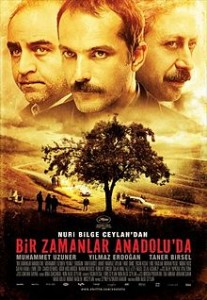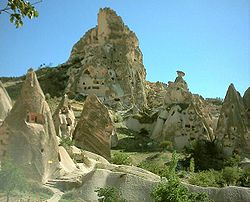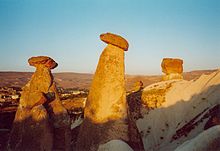 This is the newest film of world-renowned Turkish director Nuri Bilge Ceylan. This movie’s plot briefly: there is a murder in Turkey’s capital Ankara; the dead body is left somewhere in Anatolia overnight; and the next day a policeman, a prosecutor, an autopsy surgeon, the murder suspects, and an excavation crew set out to search for the body for evidence.
This is the newest film of world-renowned Turkish director Nuri Bilge Ceylan. This movie’s plot briefly: there is a murder in Turkey’s capital Ankara; the dead body is left somewhere in Anatolia overnight; and the next day a policeman, a prosecutor, an autopsy surgeon, the murder suspects, and an excavation crew set out to search for the body for evidence.
In this film, Nuri Bilge Ceylan’s characteristic non-dramatic plot and beautiful cinematography is pronounced and it does not betray the expectations of fans who love this about his works. However, compared to his previous works, there are more characters in this movie and lots of dialogue in order to describe each person’s character. Although it is not dramatic, the story is stronger compared to previous works and there is an element of mystery solving. While a little bit long, it keeps you captivated and guessing until the end. The movie proceeds at a relaxed tempo so that viewers can understand each person’s character, so I’m actually glad that the movie is as long as it is since each character is quite complicated. Also, very interesting metaphors are effectively inserted at critical points. There is also a long shot where an apple that fell from a tree rolls down a hill and all the way down the stream without the scene being cut. I really wonder how these kinds of scenes are done.
If I were to describe this movie’s distinction briefly I might say that, as rain comes down bit by bit into a pool of water, each raindrop gently creates a few ripples and it resonates with or cancels out another’s ripples forever; each ripple is a different character. After watching the movie, a small stone is gently thrown into the audience’s heart and it ripples forever.
The plot simply put is “went, searched, found,” but there is a multi-layered sentiment contained within this movie. The one that I felt the strongest was the melancholy of “the man who can’t make his woman happy,” and the nihilism.
The young and handsome surgeon is divorced with no children, but the policeman says this is good since it is a crime to raise children in a world with no hope. The policeman’s child has mental problems, which has become a point of tension in his marriage and he is exhausted by his relationship with his wife. The prosecutor talks about an interesting case that he handled as if he doesn’t have any problems in his own life; after an extremely beautiful woman birthed a child, she predicted her death and then she met an unnatural death on that exact day she predicted. However, the surgeon questions whether this death was a suicide. The surgeon calmly says that the human motive for suicide is revenge against someone else. At this point, the viewer can guess that the woman who left behind a 3-month-old baby after her suicide was the prosecutor’s wife. The murder suspect is being arrested for killing his friend; they were having a friendly drink together when the suspect let slip, “Your child is actually my child,” and then the ensuing fight ended with him killing his friend. This child loses his father that raised him to his biological father.
This movie has almost no female characters. The only key female character is the beautiful daughter of the chief of a poor village; the crew looking for the dead body stops and dines at this village. The daughter offers tea with the only light in the scene coming from her candle. Everyone admires her extreme beauty and each recalls the woman they were unable to make happy in their own life, but none of them actually speaks with the daughter. A fly circles around and is attracted to the light from the candle the daughter is carrying. The men say, “Beautiful women have unhappy fates,” and distance themselves from her.
This movie is an extremely clever movie. The audience may actually miss how the murder happened. Also, although depicted as kind and intelligent in the movie, the surgeon makes an unexpected decision at the end. We are left wondering what his intention was and what he feels as he gazes out his window. Was this an act of kindness from a man to a distant woman, and can he show such gentleness to the women in his own life?
Since the riddle and solution are mixed together within the story, this certainly is not a straightforward movie. Whenever I watch movies by this director, I wonder if the sense of emptiness flowing through the bottom of his movies is due to his character or the gloominess of Turkey’s society that has many complicated problems.
 Turkey is geographically and culturally between the east and west, between European and Asian culture. Anatolia, also known as Asia Minor, is the gate to Eastern culture while Istanbul is the gate to Greek and Western culture. The area is very religious and many are Muslim. This area is the source of the Tigris and Euphrates Rivers so a unique culture has developed here since ancient times. Considered a minority, many Kurds reside in this area now. When Turkey faced the crisis of possible disintegration as a nation after their defeat in World War I, Anatolia became the center of a nationalist movement. Therefore, Turkey’s capitol Ankara is in central Anatolia. The Anatolia area is still poor, has a severe subarctic climate, and is very religious, as compared to the picturesque and international and growing economy of Istanbul. I think the director may have a special sentiment toward Anatolia, but it is hard for me to know for sure.
Turkey is geographically and culturally between the east and west, between European and Asian culture. Anatolia, also known as Asia Minor, is the gate to Eastern culture while Istanbul is the gate to Greek and Western culture. The area is very religious and many are Muslim. This area is the source of the Tigris and Euphrates Rivers so a unique culture has developed here since ancient times. Considered a minority, many Kurds reside in this area now. When Turkey faced the crisis of possible disintegration as a nation after their defeat in World War I, Anatolia became the center of a nationalist movement. Therefore, Turkey’s capitol Ankara is in central Anatolia. The Anatolia area is still poor, has a severe subarctic climate, and is very religious, as compared to the picturesque and international and growing economy of Istanbul. I think the director may have a special sentiment toward Anatolia, but it is hard for me to know for sure.
 Anatolia is known for the magnificence of world heritage sites like Cappadocia, but the director avoids the scenic jagged rocks and instead strictly captures the leisurely grasslands, looking for areas with winding roads. The movie is like this scenery—a grassy plain undulating forever.
Anatolia is known for the magnificence of world heritage sites like Cappadocia, but the director avoids the scenic jagged rocks and instead strictly captures the leisurely grasslands, looking for areas with winding roads. The movie is like this scenery—a grassy plain undulating forever.
